The making of Divinity: Original Sin 2
From a small arena prototype to our 2017 game of the year.
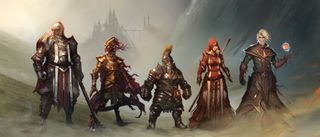
This feature was originally published in issue 316 of PC Gamer UK and issue 304 of PC Gamer US. Get our lovely-looking magazine delivered to your door every month and save a bunch of money on the cover price.
With Divinity: Original Sin, developer Larian Studios created its most successful game in its two-decade history, netting a plethora of accolades and comparisons to genre titans like Ultima V2. Not content, the studio rolled out an overhauled Enhanced Edition, all the while working on a fresh prototype. That would become Divinity: Original Sin 2, Larian's newest and biggest success story.
That Original Sin 2 prototype started life as an arena mode, like the one that's still in-game today, allowing the designers to quickly create scenarios and fights to test new and returning systems.
"We were using it to prototype how combat would feel, what we were going to do with Action Points, what new elemental combinations we could come up with, and how we'd shape the roles and archetypes," Nick Pechenin, Larian's systems designer, tells me. And it was through that prototype that the team came up with new concepts, like the Source Points system that lets players build up to powerful moves.
With these first experiments, the arena mode became a laboratory. "We knew it had to be deep, with a lot of systems and a lot of combinations that we’ll probably never see. We had people teleporting, lava surfaces everywhere and everyone going around killing civilians left and right."
Once the Enhanced Edition was finished, work on Original Sin 2 began in earnest, and Larian quickly tripled in size. "Original Sin 2 was the first time where we had sufficient resources to do everything well, and even then we had to scramble," recalls Swen Vincke, Larian’s founder. "We had some growing pains. We grew in one year from 40 people to 130, so that was quite a challenge to manage. We went from one studio in Belgium to four international studios working on the same game."
A lot of the new members of the team hadn't made a game before, including several writers. Vincke wanted to bring in screenwriters from outside Larian to help with dialogue, but they had to learn an entirely new way of doing things.
The biggest gaming news, reviews and hardware deals
Keep up to date with the most important stories and the best deals, as picked by the PC Gamer team.
New blood
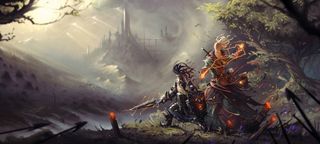
"There are always pros and cons, of course, and there's the learning curve and making sure people understand what it is to write for a game instead of writing a screenplay," says writing director Jan Van Dosselaer. "It's a linear experience compared to a game like this, which is completely open. But I think when looking from one game to the next, the dialogue is a lot more conversational. It’s clear we tried to do something different."
For both Vincke and Van Dosselaer, it was imperative that extra attention was given to the narrative and the dialogue, two things they'd already tried to improve in the Enhanced Edition. "One of the main critiques of Original Sin was the story could have been better and could have benefited from more gravitas," Van Dosselaer remembers. "We took that to heart. So the main thing we wanted to do was work on a better, more epic narrative, give it more gravitas, and invest more time on characters and character development." From that goal, the origin system was born.
The system lets players not only pick a character with a fleshed-out backstory, identity and personal quest, they could choose to bring the other origin characters along as party members. This means it's possible to experience up to four origins in one playthrough, from different perspectives. It proved to be Original Sin 2's big hook, and the thing that most clearly set it apart from its progenitor. It also proved to be a huge challenge for the writers.
"The term that I use is 'spicy', like a bowl of curry. It has to be spicy or it's boring. If you're only killing enemies and dealing damage without thinking, you’re not engaged. "
Edouard Imbert, senior combat designer
"When we did our postmortem after releasing Original Sin 2 to learn the lessons about what we did wrong, what we could do better," Vincke says, "one of the scripters asked us to never let origin moments interact with each other ever again. But that’s what people like the most!"
The origins and quests intersect, not only with the main quest, but the personal quests of your companions, too. You might need to talk to a character because it's integral to the main story but your companion is adamant that they get to kill that person. The writers had to consider the world state, what quests might already be underway, how killing one NPC will affect other quests—all the while trying to make sure that actions would have consequences.
"The one thing I don't want to do again is to write two of them," Van Dosselaer laughs. "I wrote Red Prince and Sebille, and I love both characters, but especially near the end it got schizophrenic writing the two of them at a very quick pace. I’d prefer to have just one baby to focus on. You have a lot of these conversations where the characters reflect on things, and I brought all of these conversations together and just spent days writing all the observations of all the characters, working like a machine."
Repeating success
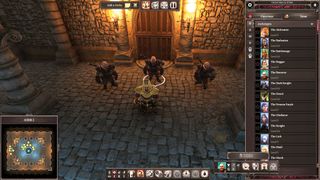
While all of this was going on, Larian was also running a Kickstarter. After years of relying on publishers, and sometimes being burned by them, the studio had become independent, but it needed the community that had sprouted up around its games. With one successful campaign and an extremely well-received product under its belt, the second Kickstarter quickly smashed targets. The game was fully-funded in less than 12 hours.
Even with that security, Larian didn't slow down. On the last day of the Kickstarter, Vincke and other members of the team ran a 24-hour stream, which included PvP battles in the arena. And on the other side of the wall, everyone else was still working, getting things ready for the inevitable events and preview demos.
Pechenin recalls the first PAX showing. "We were just showing the arena prototype and then we started to show off the beginning of Fort Joy [the first act’s main area]. What it allowed us to do was see what people came up with while using Bless and Curse." These new skills introduced another layer to the magical combos and elemental surfaces. So you could summon a shower of rain, which created puddles of water, and then you could bless those puddles, buffing the characters standing on them. Pechenin was also keeping an eye on how players handled their AI opponents in case they needed to be tweaked. They did.
While Original Sin's NPCs follow scripts, its sequel's AI constantly makes calculations to determine the best way to murder the player. That also makes it a surprisingly good teacher. "In Original Sin 2, the AI will always know what will happen when it throws a fireball at an oil barrel. What was cool, and we saw it pretty early, was that the AI started teaching players new mechanics. Even if you didn't know anything about the surfaces or how any of this works, you'd see the AI electrifying and freezing water or exploding puddles of oil and poison. You could learn just by watching."
The AI could be too smart, though. "Our combat designers had to remove crowd control from the AI," Vincke explains, "because it focused on one character, made sure to destroy their physical and magical armour, and then would start to control it, then kill it. That wasn't fun because one guy was dealing with everything, but it was a dominant tactic. So we had to nerf it a lot."
The AI knew the systems too well, and was only too happy to exploit them before the nerf. This extended to NPCs not designed for combat, too. If you attack an NPC, they'll try to use all their tricks to survive. If that NPC happens to be a potion vendor, then they'll obviously start quaffing down magical elixirs. Larian wanted them to keep doing that, but had to stop them from drinking powerful legendary potions that might be related to a quest, or at least would be highly coveted by players.
It was a balancing act, however, because one of the appeals of the first game's combat was that it could be pretty tricky. Larian didn’t want to sacrifice the challenge and complexity of the system, even if that meant letting players die before they could figure out how to win a battle.
"Spicy"
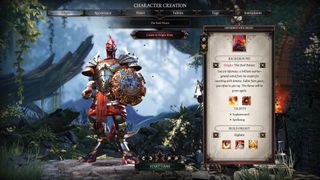
"In French, we have this saying, 'I have a splinter in my flank,' something that hurts," explains senior combat designer Edouard Imbert. "We have to put something in the flank of the player that hurts them, then they have to identify and defuse it. It could be a high-damage spellcaster. The fight is too hard because this one guy is too strong. Once you take care of that guy, the fight becomes manageable. Of course, you want to have a puzzle with more than one step, boxes within boxes."
Imbert doesn’t really think he makes fights—he creates scenes. With puzzles and dialogue and little secrets. "The term that I use is 'spicy', like a bowl of curry. It has to be spicy or it's boring. If you're only killing enemies and dealing damage without thinking, you're not engaged. The fight has to communicate with you as an equal; it must not insult your intelligence. I remember some QAs telling me that there was a fight where you had to die at least once to get it, and I was like, 'I'm okay with that.' I don’t want it to happen all the time, but some fights, sure."
When Imbert had a battle to prepare for, he'd pay Nick Pechenin a visit to find out what skills, say, a level 12 character would have and then he'd try to come up with a scene where the skill is used in some way. Players automatically get the Bless spell, for instance, so Imbert would know that, after a certain point, he'd be able to create a scene with a cursed NPC or cursed fire, and players would be able to figure out that they'd need to use Bless to get out of the fight alive.
Sometimes, however, the objective is to push players. "We give the player something that they can do, like healing themselves using Restoration, but at some point we disable that by creating a character that bleeds cursed blood that inflicts decay, so they can't heal themselves. We give them a nice thing and then take it away, briefly. We don't do it too much because then it starts to show, but sometimes the story creates good opportunities for it."
The problem for the designers was that, quickly, it becomes impossible to predict what skills a player might have or how their party will have evolved. With few limitations to progression, countless weird and wonderful combinations are possible. Every fight needed to have multiple solutions, then, to take into account the broad variety of potential character and party builds.
"Luckily we have a tool, a party editor, which allows me to assemble a party with certain archetypes, which I can save," says Imbert, with no small amount of relief. "So I’ve got a party which is a warrior, rogue, ranger and mage, and I have another that's all rogues. And for a level in the game, I try to have five different parties. So I can test it with different groups of characters. I usually test a fight, like a simple scene, 12 or 15 times. For the final boss, I spent ten days on it. There was always something broken." New tools came to the rescue more than once.
Conversation starter
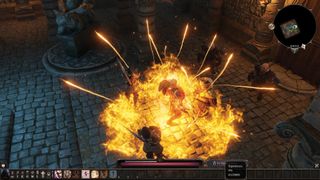
"People don’t see it, but obviously our writing isn't done on paper, of course, it’s done in actual tools," says Van Dosselaer. "The better the tools, the more you can do and the less constrained you feel. One of the major downsides of Original Sin was that the tool wasn't dialogue-friendly. You could tell it had limits that made it a lot more difficult to mimic actual conversation, which is why you have parts where you just get to ask a question and then read a block of text. With the new tool we can really recreate proper conversations with banter and a good back and forth. If you look behind the scenes at what dialogue looks like in the editor, then sometimes it's huge, with all these branches that you'll never see. It creates all these unique experiences. It's a lot broader because of that."
With the release date imminent, the script still wasn’t finished. Vincke remembers that, at one point, there were five studios recording while the team was doing continuous rewrites. Almost up until the last moment.
"We rewrote the game all the way up to the week before release, and there were many conversations still being modified. It was worth it because you sensed in a lot of the permutations of the game that there was always a story that made sense, sometimes not so good, sometimes a lot better than other times. But I think that was part of the success of the game. The downside was that the translation companies and voice recording companies were going bananas. We were super lucky that they supported us or it would have been a really big disaster."
Despite this, Original Sin 2 launched in time, with a finished script and fully-voiced dialogue. That was when the team could finally sit back and watch players do things that they'd never even considered.
"We’re still getting gifs of players doing something crazy, with jumps or stacking barrels in advance and all sorts of things," says a grinning Pechenin. "If you can think it up, it should work. It was very important for us to have all the systems work without restrictions."
Check out our history of Larian piece here, too.

Fraser is the UK online editor and has actually met The Internet in person. With over a decade of experience, he's been around the block a few times, serving as a freelancer, news editor and prolific reviewer. Strategy games have been a 30-year-long obsession, from tiny RTSs to sprawling political sims, and he never turns down the chance to rave about Total War or Crusader Kings. He's also been known to set up shop in the latest MMO and likes to wind down with an endlessly deep, systemic RPG. These days, when he's not editing, he can usually be found writing features that are 1,000 words too long or talking about his dog.
Most Popular

